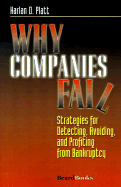|
|
|
|
||||||

|
Why Companies Fail: Strategies for Detecting, Avoiding, and Profiting from Bankruptcy
By Harlan D. Platt 1999/01 - Beard Books 1893122050 - Paperback - Reprint - 169 pp. US$34.95 A revealing presentation of the causes of business failure and the strategies for avoiding bankruptcy and liquidation. Publisher Comments This revealing book is a straightforward presentation of the causes of business failure and the strategies for steering a troubled company away from the threat of bankruptcy and liquidation. Five major financial traps that can lead to failure are identified, and each trap is illustrated with actual cases of well-known companies. Distressed companies are offered hope with examples of asset, liability, and corporate maneuvers that can help guide failing businesses to firmer ground. From the back cover blurb: A business fails every hour of every day in the United States. Why? What kinds of problems have these businesses run into? And what steps can corporate executives and managers take to avoid the same fate for their own companies? Why Companies Fail answers these questions and more, in a straightforward presentation of the causes of business failure and the strategies for steering a troubled company away from the threat of bankruptcy and liquidation. Author Harlan D. Platt identifies five major financial traps that can lead to failure, and illustrates each trap with actual cases of well-known companies, including Wickes, W.T. Grant and Braniff. Dr. Platt offers distressed companies hope, too, with examples of asset, liability and corporate maneuvers that can help guide failing businesses to firmer ground. Review by Regina Engel Originally published in 1985, Why Companies Fail remains a useful, simple guide for the average businessperson to identify and avoid the traps that lead to bankruptcy. Noting that libraries are full of books containing prescriptions for financial success, the author chooses to focus on failure so that it can be avoided and the number of bankruptcies reduced. He also feels the book fills a gap in the education of students and business people who are not otherwise instructed in how to manage a company on the brink of failure. To aid in understanding his analysis, he classifies businesses into four categories depending on the strength or weakness of their product and their financial condition, calling them eagles, tortoises, condors, and dinosaurs. As he explains, "[e]agles have healthy products and finances, tortoises have weak products, condors have weak finances, and dinosaurs have weak products and finances," Condors and dinosaurs are the primary focus of the book, since financial issues lend themselves more to generalization. The five chapters that are the heart of the book set out the specific financial reasons for business failure, any or all of which could precipitate the bankruptcy. Each contains actual cases of companies to illustrate the type of problem. Problems in a company's cash-flow cycle are discussed in Chapter 3. The author opines that mismanagement in this area is probably the largest single cause of failure, but maintains that staying on top of the problem can be accomplished with a good spreadsheet program and that with the proper information "every worthy business" should be able to obtain the funds it needs. In Chapter 4 the topic is how to avoid "getting buried under current assets." The advice here is to monitor both inventories and accounts receivable by comparing their size to the company's investment in total assets and to analyze carefully when that ratio rises whether that is the desired goal. In Chapter 5, entitled "Getting Squeezed by Equipment," the author can only warn of the risks involved in investing in long-term assets. He concludes: "Unfortunately, there are no fail-safe methods for choosing the right amount of fixed assets since the optimal quantity depends an the unknown level of future sales." Chapter 6 deals with a company's debt-to-equity ratio, emphasizing that a major disadvantage to debt financing is that it limits alternatives, and a firm so burdened is allowed fewer mistakes than one with sizable net worth. In Chapter 7, entitled "Getting Pinched by Short-Term Debt;" the author describes the trap where management decides to speculate on lower future interest rates and is wrong. Chapter 8 sets forth methods of detecting bankruptcies to enable the reader to identify the condors, and Chapter 9 aids failing companies by an examination of how other companies in similar situations have extricated themselves. Chapter 10 contains advice on investing in bankrupt companies. Following a concluding chapter summarizing his concepts, the author includes two appendices, one setting forth tables of failure rates, which, of course, does not include what has happened in the last fourteen years, and the second providing basic accounting for nonfinancial readers. A glossary is also included for those whose background in the field is limited. From A. Tavakoli - Choice The book is written for those who may not be trained in finance or accounting but who need to understand the obstacles responsible for most business failures. Recommended for both the general and academic reader, community college level and above. From Debra Ann Hatten - The Christian Science Monitor (Eastern edition) This book, written for the nonfinancial reader, records conventional reasons for business failure: cash-flow problems, taking on too much debt, and starting out with too little capital. But it continues where other books may stop, pointing out to those who are nearly bankrupt how to avoid bankruptcy. It describes reorganization techniques that have pulled companies out of the holein recent years--such as refocusing market niches and converting debt into stock. The book uses minicases to illustrate these methods. The author also gives potential investors a score card to select potential turnaround companies when picking up the high-risk, high-yield bonds (not stocks) of near-bankrupt or bankrupt companies.
|
||||||||||||||||||||||||||||||||||||||||||||||||||||||||||||||||||||||||||||||||||||||||||||||||||||||||||||||||||||||||||||||||||||||||||||||||||||||||||||||||||||||||||||||||||||||||||||||||||||||||||||||||||||||||||||||||||||||||||||||||||||||||||||||||||||||||||||||||||||||||||||||||||||||||||||||||||||||||||||||||||||||||||||||||||||||||||||||||||||||||||||||||||||
|
|
|
home
| about us
| contact us
| related
sites |